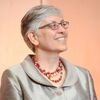I meet many 20-year-olds on the cusp of aging out of foster care. So many have beaten the odds and are on the path to successful adulthood. Others still struggle to find that path. All have faced trauma, often a lack of education and other hardships that have long-lasting effects.
The year they were born, 1996, was dangerous for kids living in DC, and no more so than for those growing up in our poorest wards. Nearly 80 teens were murdered across the city that year, mostly in Wards 5, 7 and 8. The courts saw an increased in child abuse cases. Thousands of children languished in classrooms, making little progress toward gaining the skills necessary to succeed. Only one in two high school students graduated.
DC struggled to protect its children. Almost 8,000 were under government watch because of abuse and neglect and 3,000 were in foster care. Many were in foster care for years without much effort to find them permanent families. It was a "bleak" time, according to an assessment of children's well-being published that year.
It's also the year Children's Law Center first opened its doors.
A series of public reforms were underway, including efforts to reshape DC's schools, child welfare and mental health systems, and pieces of the social safety net. But there had been little progress for children.
That's what led three tenacious lawyers -- James Marsh, Diane Weinroth and Ken Noyes -- to start Children's Law Center.
They believed DC children deserved better and were tired of fighting the same battles every day. Joining forces, they envisioned a team of dedicated advocates who combined tenacity, legal skills and a deep knowledge of how the system was supposed to work to protect children. They became Children's Law Center's first board of directors.
In our first year, Children's Law Center helped almost 200 children and families. Most of our efforts were focused on ensuring children grew up in permanent, stable families.
Flash forward to 2016. A lot has changed since then.
Almost from the start, we realized children needed more than permanent families to thrive. Children who had been abused or neglected needed to recover from that trauma. All children required classrooms that could meet their specific needs. Their housing and neighborhoods had to be safe. They needed access to health care. Children's Law Center grew to take on a more comprehensive approach with the belief that every child deserves to grow up with a stable family, good health and a quality education.
We now fight for more than 5,000 children and families each year - reaching 1 out of every 8 children in Wards 7 and 8. And Children's Law Center grew to include 100 lawyers, social workers, investigators and other staff - with hundreds more volunteer attorneys who help us reach even more children.
When it comes to children's well-being, much of the District's changes since 1996 have been for the better.
It's been a tumultuous time, with literally every government agency responsible for children's well-being subject to federal oversight at one time or another. But because we work with many of these agencies day in and day out, I can tell you that they have made mostly steady - albeit slow - progress.
The good news is that, overall, the status of DC's children has improved over the past 20 years. DC children born today have a better chance than the previous generation to make it to adulthood.
Children are more likely to be screened for development delays in the youngest years when intervention can do the most good. Our schools are making some progress, especially at the elementary school level. And if something goes wrong and a child can no longer live with her parents, she is much more likely to be placed with a relative than with strangers. As a result, DC has dramatically reduced the number of children living in foster care to about 1,000 children.
Even with this progress, too many of our children are being left behind. This is especially true in Wards 7 and 8. Despite the economic recovery for much of the city, these are the neighborhoods where children continue to live in extreme poverty. And our government agencies are not yet up to the task of protecting our most vulnerable children - let alone help them thrive.
I know from 20 years of work that lifting families out of poverty is the best thing DC can do to improve children's lives. Poverty and family instability go hand in hand. When children grow up in poverty, they are more likely to go hungry, experience homelessness and suffer the consequences of toxic stress. As a result, these children have worse health outcomes and are less likely to graduate from high school than others.
Today, one in four DC children live in poverty - and the number in our poorest wards is closer to one in two children. We see these families in our legal practice every day. It's one reason we've increased our policy advocacy to press for funding for the Temporary Assistance for Needy Families (TANF) program and other areas of the public safety net to ensure children in poverty have their basic needs met, no matter what.
As Children's Law Center looks to the next 20 years, we will continue to innovate and advocate to meet the changing needs of children in our city. And while we find solutions to the system-wide issues we will continue to fight, child by child and family by family, to ensure that our most vulnerable children are safe and have a chance to thrive.
I look forward to sharing stories and updates throughout 2016, our 20th anniversary year, about the children and families we have met along the way and what the future holds for children in DC.
Thank you for being a part of their success.
